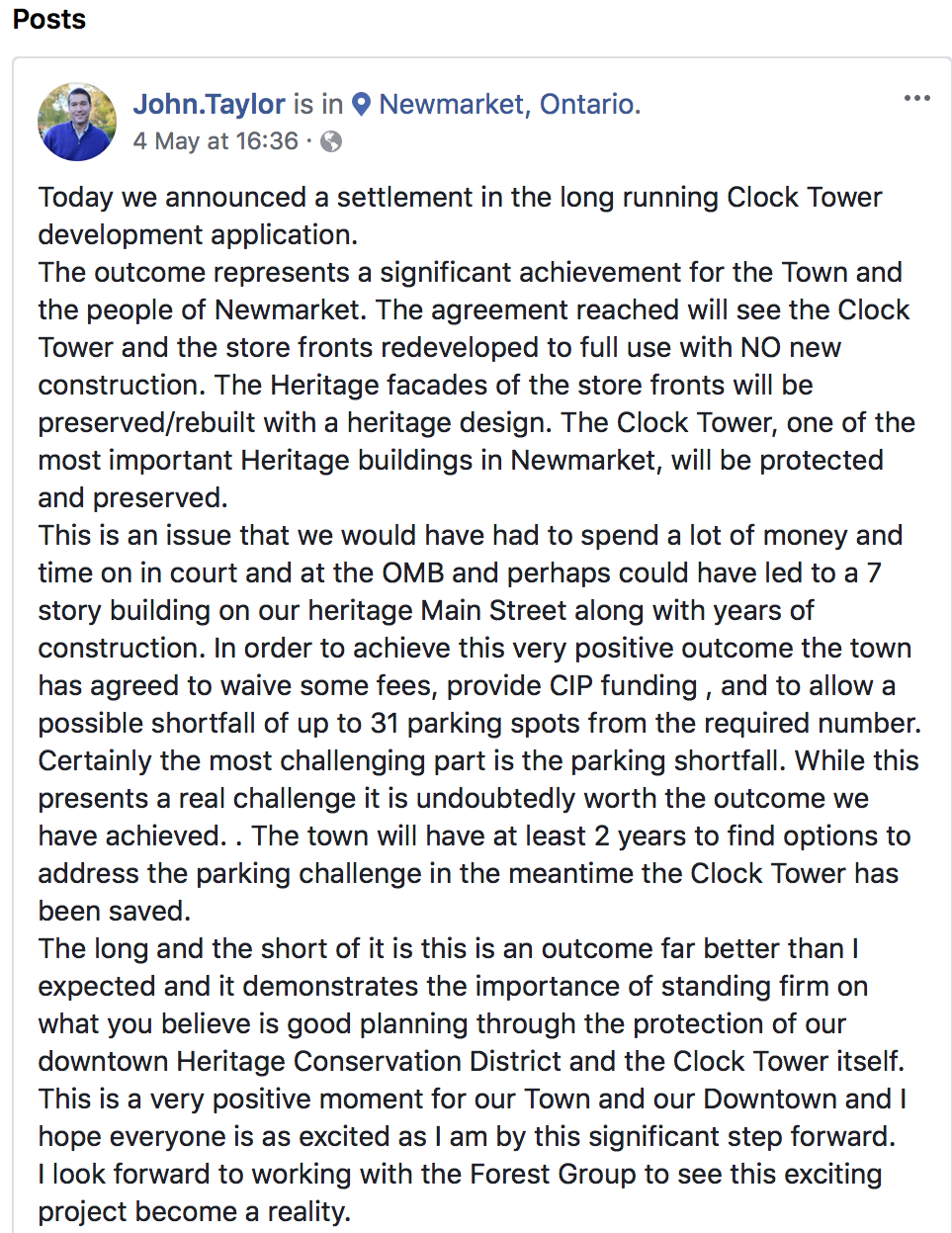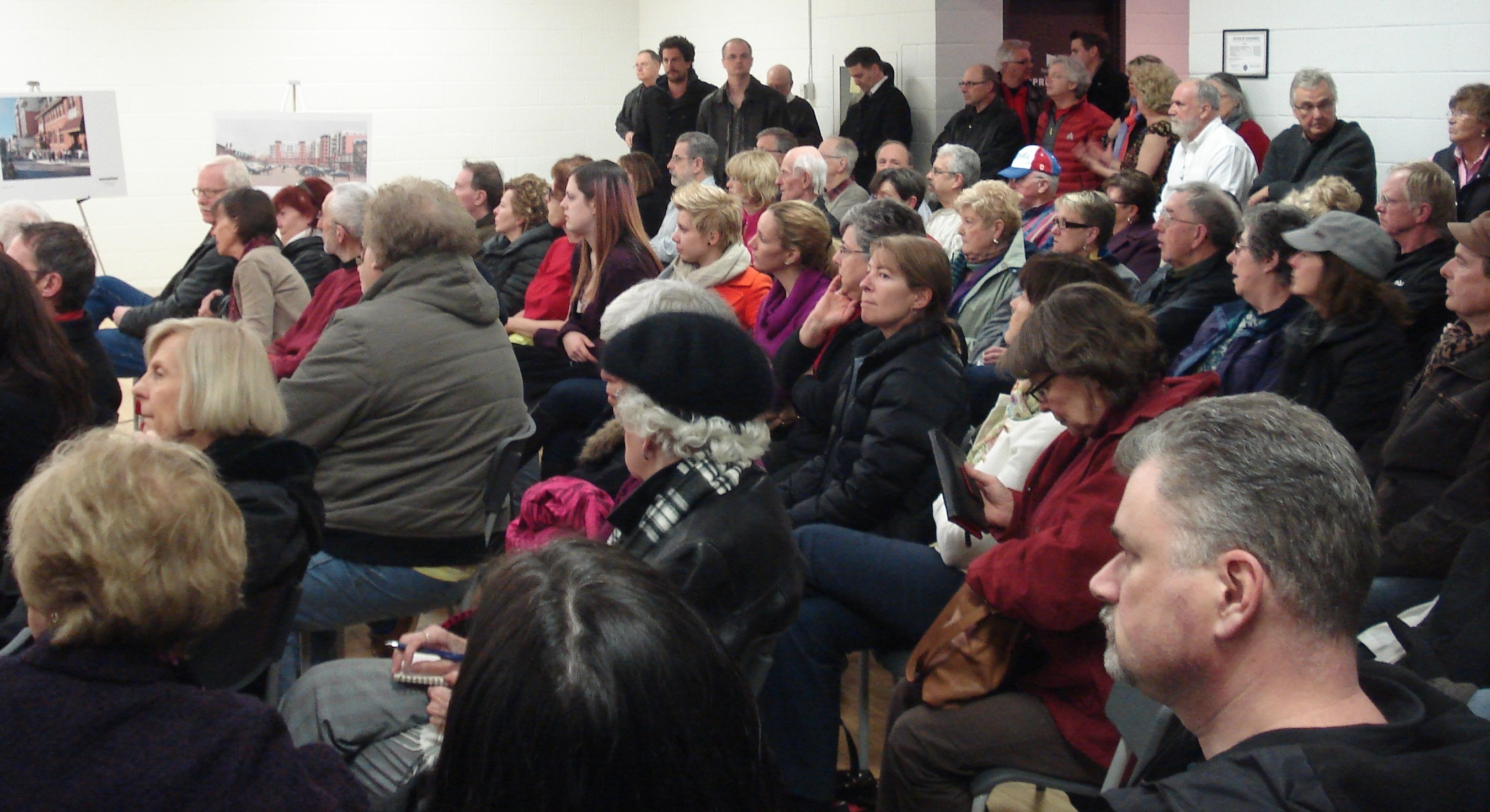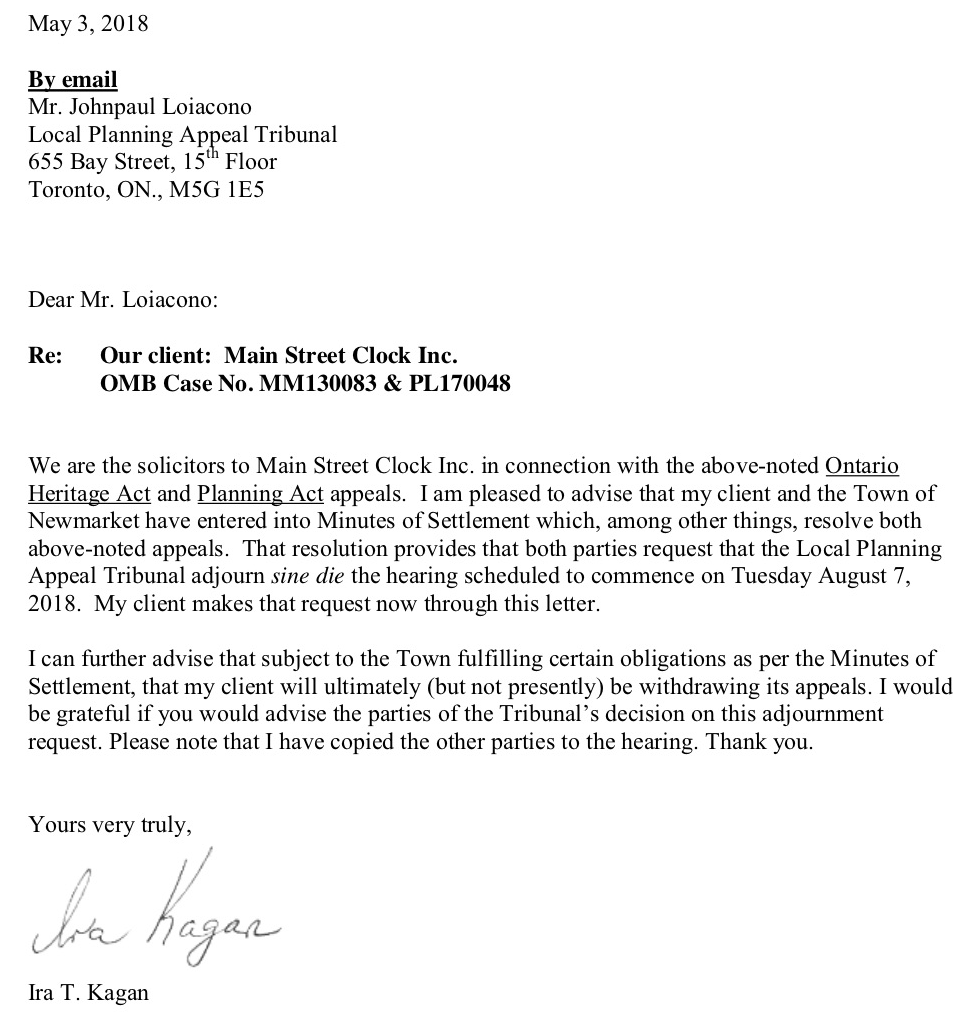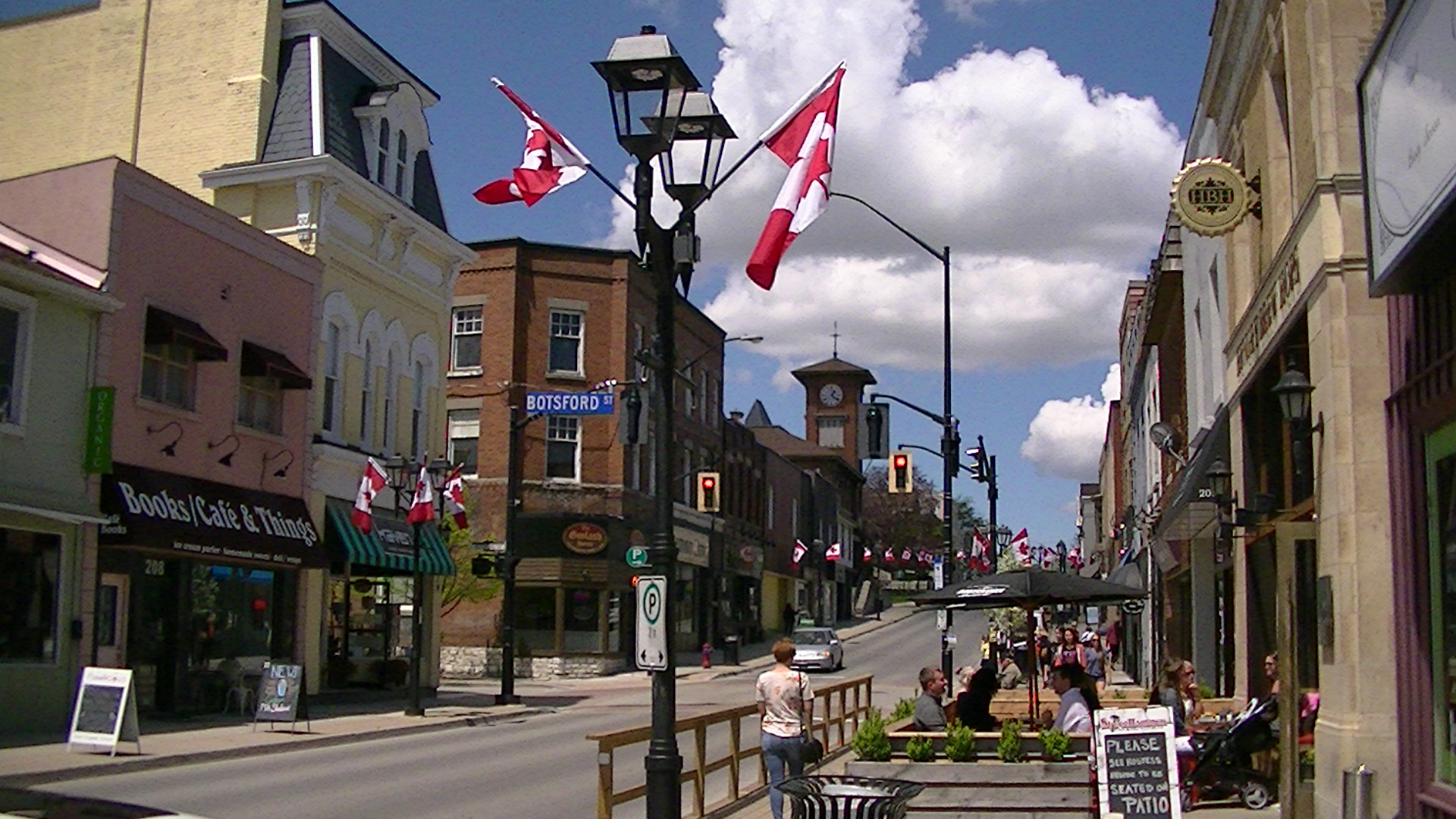- Details
- Written by Gordon Prentice
Yesterday I wander into Christine Elliott’s HQ in the Nature’s Emporium Plaza and ask when the candidates’ debate will be.
I am told it’s coming up in the morning of 24 May 2018 at the Cardinal Golf Club – outside the riding!
Surely some mistake?
It turns out there are two events that bring all the candidates from the three main parties together: the first organised by the Aurora Chamber of Commerce on 16 May and the second, organised by the Newmarket Chamber of Commerce and focussed on business competitiveness, on 24 May.
But so far there isn’t a debate in the riding that’s free and covers the entire sweep of Provincial responsibilities. This is shameful.
If I want to hear the candidates talk about the Ontario Chamber of Commerce platform “Vote Prosperity” I have to first register with the Chambers and fork out $40 for the Aurora event or $35 for the Newmarket breakfast at the Cardinal Golf Club.
Whoaaa! Not good enough.
Surely, someone somewhere is planning to organise a debate that the great unwashed can go along to for free?
What about the Era Newspaper taking the initiative? Or the Auroran?
Chris Ballard tells me:
I am not aware of a public debate. Would love to have one.
I am sure he is speaking for all the candidates. So let's have our local newspapers organise one.
The much-anticipated Party leaders debate – the first of three - is on CTV this evening starting at 6pm.
This email address is being protected from spambots. You need JavaScript enabled to view it.
- Details
- Written by Gordon Prentice
The agreement on the Clock Tower, struck between the Town of Newmarket and the developer Bob Forrest and announced at the close of play on Friday afternoon, should be welcomed.
It ends the long debilitating uncertainty over this key block of buildings in the old downtown and it tentatively sets out a mechanism and a timetable to bring the heritage properties back into use. There will be no new building on the Forrest lands (other than, possibly, some above ground garage structures immediately behind 184-194 Main Street South) although the Town implicitly acknowledges that in the future there may be redevelopment of the 1956 extension to the Clock Tower, the old telephone exchange.
Importantly, as soon as the deal is signed off, the Forrest lands immediately fold back into the Heritage Conservation District with all the protection that designation affords.
This wouldn’t have happened without a strong and vocal coalition of interests coming together and sticking with the issue over the years.
The resolute position taken by the Town’s Heritage Advisory Committee was pivotal. The Business Improvement Area Committee steadfastly opposed the Forrest proposals from the word go. The Heart of Newmarket Citizens’ Group provided invaluable expertise and strategic thinking. The local branch of the Architectural Conservancy of Ontario spread the message that old buildings with a story to tell are worth saving. And countless individuals made it clear they were not prepared to accept what the Mayor said was good for them.
Astonishingly, Van Trappist now brazenly describes the settlement as a win-win despite it being the polar opposite of what he and his enablers in the senior ranks of the Town’s staff have been working on for years.

Van Trappist, now the mouthpiece for others, says:
“We are excited that we have reached a solution that is a win-win for the Town, the developer, the downtown area and Newmarket as a whole.”
What’s in it for the Town?
First and foremost, the return of a vibrant and healthy Main Street. For years Forrest’s boarded-up and crumbling properties have blighted the heart of the old downtown.
The Town wants an early end to the dereliction. The restoration work and any construction is to begin as soon as possible but no later than 15 December 2019. If Forrest converts the upper levels of the Main Street buildings to office use the Town will allow him “to demolish the single storey additions at the rear of the Main Street buildings” to create parking spaces.
The settlement immediately placates a very large number of people who have been outraged by the way in which the Town handled the Clock Tower application. The willingness of senior staff to present false information to councillors and the public about the Floor Space Index was unconscionable. The report on 28 November 2016 was going up to Committee for decision.
At some point the endless stonewalling by senior Town staff of legitimate requests for information must stop. We still don’t have details of the so-called “agreement in principle” between the Town and Forrest in June 2013. There is absolutely no reason why that cannot now be released into the public domain.
The latest agreement avoids expensive litigation at the Superior Court on the Market Square land ownership issue which would expose the full extent of the Town’s incompetence in not closing the deal it had with Michael Bryan back in 2003.
It saves the embarrassment of an OMB Hearing in the immediate run-up to the Municipal elections where all manner of hidden skeletons might have been uncovered.
It allows the fraught relationship with the downtown business community to be re-set. Mayoral hopeful John Taylor still envisages some kind of relaxation to the development rules within the Heritage Conservation District but this is for the future and, importantly, he says there will be public consultation. No more development by fiat.
What’s in it for Bob Forrest?
Forrest is still spitting feathers. He believes he was led up the garden path by the Town and that he had an agreement in principle for his proposed development dating from June 2013 that the Town welched on. The eight-page letter he left with councillors when they turned down his proposal on 28 November 2016 was dripping with venom and resentment.
The Town, ever forgiving, will make up to $100,000 available to Forrest for the restoration of the old heritage properties “to the extent that the “New Development Concept” qualifies and meets program criteria.”
If the Clock Tower is developed for residential uses the Town will sell him land-locked land in Market Square (currently housing electrical gear) for $10, the option to be exercised within 5 years.
Forrest’s wife, Coleen, told the press on Friday that getting a sewage link-up to the proposed Clock Tower development before 2026/7 prompted a rethink:
“Despite the expectation of success at the scheduled OMB hearing, the planned Clock Tower condominium building would be unlikely to receive servicing allocation until 2026-27… In the face of unparalleled enthusiasm on the part of over 200 prospective condo buyers, Main Street Clock Inc. has been forced to revisit its business plan for the Clock Tower and Main Street properties.”
“We look forward to sharing in the near future an exciting new concept for this beautiful heritage space — a concept which will bring economic stimulus to downtown Newmarket.”
That is elegant face-saving. In reality, the Forrests – who stood to make $10m clear profit from the earlier development proposal – are furious.
Forrest told his business tenants on 5 January 2016 before he evicted them:
“I don’t want to sound at all arbitrary but it is very real for me. My business isn’t renting stores. My business is building buildings and I want to get to the point that I can build my building at the earliest possible moment.”
What’s in it for the downtown area and for Newmarket as a whole?
Old Main Streets across Ontario are under assault by developers as never before. Municipalities, frightened of their own shadows, routinely capitulate, fearing the costs of going to the OMB. Those Main Streets that survive largely intact – such as Newmarket’s – will increasingly have a rarity value which the Town, its businesses and the wider community can cash-in on.

Maybe the former business tenants, unfairly evicted by Bob Forrest, will have the opportunity to return to the heritage buildings they once occupied. I hope so.
Parking remains an issue. As I see it, there is probably no long-term “solution” for parking in the heritage downtown, just a series of short-term fixes. John Taylor says the terms of the settlement leave the Town with a possible parking shortfall of up to 31 spaces but:
“the Town will have at least two years to find options to address the parking challenge in the meantime the Clock Tower has been saved.”
In one form or another, the Clock Tower saga has been running since 2011. That’s way too long for members of the public to stay engaged. People have their lives to lead.
But, that said, unless we stick with it over the long term – and that is quite the challenge - the developers win. They have the time and the money.
Forrest says quite candidly they make things happen and get results:
“by leveraging our strong reputation and existing relationships with municipal staff and politicians.”
And to get his development going Forrest was, of course, prepared to allow demolition by neglect. In May 2016, Forrest said of the historic commercial properties he owns:
“The roofs leak. The roofs and the floors sag.”
Now he will have to fix them.
This email address is being protected from spambots. You need JavaScript enabled to view it.
- Details
- Written by Gordon Prentice
The Town of Newmarket has now released the terms of its settlement with the developer Bob Forrest. The details are here.
I'll post a commentary once I've figured out what's happening.
This email address is being protected from spambots. You need JavaScript enabled to view it.
- Details
- Written by Gordon Prentice
Last night I wander along to Chris Emanuel’s campaign launch in the Veterans Hall at Millard. 
He is running for Regional Councillor, hoping to step into John Taylor’s shoes if – as widely assumed - Taylor effortlessly ascends to the Mayoralty.
There are balloons and razzamatazz. And a pay bar.
It’s lively and there are lots of people.
No sign of John Taylor but I see Tom Taylor so the dynasty is represented.
And I see the smiling Ward 4 councillor, Tom Hempen, and Dave Kerwin from Ward 2.
After a hagiographic introduction from his former school teacher, Chris sets out his stall which he says is full of big, bold and positive ideas.
He has dipped his toe into the private sector and now returns to public service refreshed and reinvigorated and brimming with new ideas.
That’s the gist of it.
He said he wanted momentum to launch his campaign and, on the evidence of last night, I think he has the edge on his rival, the veteran councillor Tom Vegh.
 After 15 years on the Council in one form or another, Tom Vegh has abandoned his Ward 1 berth. It's time do or die.
After 15 years on the Council in one form or another, Tom Vegh has abandoned his Ward 1 berth. It's time do or die.
This is shaping up to be quite the contest.
But here’s my advice to Tom. In politics, never do good by stealth.
If you want to be taken seriously then get your website up and running in the next 24 hours.
It’s been way, way too long undergoing maintenance.
If you’ve got something to say we want to hear it.
Loud and clear.
This email address is being protected from spambots. You need JavaScript enabled to view it.
- Details
- Written by Gordon Prentice
The Town of Newmarket has now agreed Terms of Settlement with the Clock Tower developer, Bob Forrest, which means the OMB Hearing scheduled for August 2018 will no longer go ahead.
It is likely that the application coming before the Superior Court later this month on who owns the contested land in Market Square will also be pulled. 
Earlier today (3 May 2018) Forrest’s lawyer Ira Kagan told the Local Planning Appeal Tribunal (the successor body to the OMB) that Forrest and the Town of Newmarket had agreed the terms of a settlement which resolved the appeals currently before the OMB. Kagan says the Town and Forrest want the OMB Appeal due to start on Tuesday 7 August 2018 to be adjourned indefinitely.
“I can further advise that subject to the Town fulfilling certain obligations as per the Minutes of Settlement, that my client will ultimately (but not presently) be withdrawing its appeals. I would be grateful if you would advise the Parties (Forrest’s Main Street Clock Inc, the Town of Newmarket and the Heart of Newmarket Citizens’ Group) of the Tribunal’s decision on this adjournment request.”
Settlement terms still a mystery
The Town has settled with Bob Forrest but we do not yet know on what terms. What are the obligations the Town must fulfill? We shall find out tomorrow afternoon according to Bob Kwapeese.
Should we be celebrating?
If Forrest's Clock Tower project is now stone cold dead, never to be resurrected, we should all give thanks.
But the question in my mind is this: what is Forrest getting from the Town in return for pulling out of the OMB Hearing? And what is he getting for dropping his opposition to the Town's application to the Superior Court on the land ownership issue (if that is, indeed, what is happening.)
Personally, I thought the Town was in a pretty strong position even if it lost in the Superior Court on the Market Square land ownership issue. (The Town’s deal, some 15 years ago, with Michael Bryant - who sold his Main Street properties to Forrest - was never formally closed by the Town. It was and remains a stellar example of Newmarket Council’s ineptitude.)
Kagan was poised to argue at the Superior Court that if the Town hadn’t gotten round to closing the deal after so many years it was no longer operational. Anyway… all this stuff is for the lawyers.
What's the deal?
I suspect the Town has thrown Forrest some kind of lifeline, allowing him to walk away with something.
But this is speculation on my part. Unlike the leaky Councillor Kwapeese I am not privy to the details.
It is enough to say that today we learn the OMB Hearing is off.
Tomorrow we shall find out what the real deal is.
This email address is being protected from spambots. You need JavaScript enabled to view it.
Tonight I emailed the Town to ask when and where the "big announcement" will happen. I wanna be there.
Page 154 of 287
